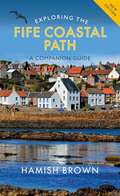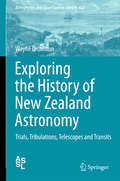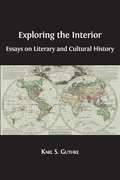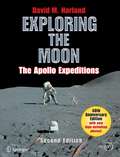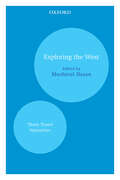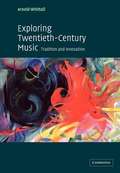- Table View
- List View
Exploring the Fife Coastal Path: A Companion Guide
by Hamish BrownThis is the ideal guide to the whole route, so rich in history and natural beauty. Designed to be used by walkers on the Path or visitors to any point along it, it introduces a wealth of castles, churches, harbours, monuments and red-roofed houses.Hamish Brown gives practical advice on all aspects of walking the Path, whether you are making a seven-day trip along its whole length or walking a short section on a Sunday afternoon. Revising his earlier guide to the route, he explores every part of the Fife coast, including the famous Forth bridges, the charming East Neuk fishing villages of Pittenweem, Elie and St Monans, as well as Anstruther, Crail and St Andrews. Along the way he provides a mass of fascinating information about people and places that can be read for pleasure and kept as the souvenir of a unique and unforgettable part of Scotland.
Exploring the History of Neuropsychology: Selected Papers
by Arthur BentonArthur Benton has long been recognized as a distinguished researcher, an influential educator, and a gifted writer. Early in his career, he was struck by the extreme divergence in the acceptance and usage of concepts and terms such as "agnosia," "amnesic aphasia," and "apraxia" by leading figures in the then young field of neuropsychology/behavioral neurology. This prompted him to explore the literature of 19th century neurology and led to an abiding interest in the historical background of current developments, which often proved to be the outgrowth of earlier formulations. In this collection of his historical papers, he traces the evolution of thought and practice in diverse areas of neuropsychology and behavioral neurology. He captures the setting in which observations and discoveries were made and shows how the limited knowledge of basic neuroscience that prevailed at the time influenced their interpretation. He emphasizes the interplay of clinical and experimental approaches in advancing understanding of brain-behavior relationships and clarifies the connections between past and present knowledge. Some of the essays are systematic accounts of developments in the broad discipline of neuropsychology while others deal with individual clinicians and scientists whose contributions are now components of current knowledge. Among the topics covered are the frontal lobes, developmental dyslexia, disorders of spatial thought in patients with brain disease and the role of cerebrovascular disease in the history of aphasiology.
Exploring the History of New Zealand Astronomy: Trials, Tribulations, Telescopes and Transits (Astrophysics and Space Science Library #422)
by Wayne OrchistonDr. Orchiston is a foremost authority on the subject of New Zealand astronomy, and here are the collected papers of his fruitful studies in this area, including both those published many years ago and new material. The papers herein review traditional Maori astronomy, examine the appearance of nautical astronomy practiced by Cook and his astronomers on their various stopovers in New Zealand during their three voyagers to the South Seas, and also explore notable nineteenth century New Zealand observatories historically, from significant telescopes now located in New Zealand to local and international observations made during the 1874 and 1882 transits of Venus and the nineteenth and twentieth century preoccupation of New Zealand amateur astronomers with comets and meteors.New Zealand astronomy has a truly rich history, extending from the Maori civilization in pre-European times through to the years when explorers and navigators discovered the region, up to pioneering research on the newly emerging field of radio astronomy during WWII and in the immediate post-war years. A complete survey of a neglected but rich national astronomical history, this does the subject full and comprehensive justice.
Exploring the History of Southeast Asian Astronomy: A Review of Current Projects and Future Prospects and Possibilities (Historical & Cultural Astronomy)
by Wayne Orchiston Mayank N. VahiaThis edited volume contains 24 different research papers by members of the History and Heritage Working Group of the Southeast Asian Astronomy Network. The chapters were prepared by astronomers from Australia, France, Germany, India, Indonesia, Japan, Malaysia, the Philippines, Scotland, Sweden, Thailand and Vietnam. They represent the latest understanding of cultural and scientific interchange in the region over time, from ethnoastronomy to archaeoastronomy and more.Gathering together researchers from various locales, this volume enabled new connections to be made in service of building a more holistic vision of astronomical history in Southeast Asia, which boasts a proud and deep tradition.
Exploring the Interior: Essays on Literary and Cultural History (PDF)
by Karl S. GuthkeIn this fascinating collection of essays Harvard Emeritus Professor Karl S. Guthke examines the ways in which, for European scholars and writers of the eighteenth and early nineteenth century, world-wide geographical exploration led to an exploration of the self. Guthke explains how in the age of Enlightenment and beyond intellectual developments were fuelled by excitement about what Ulrich Im Hof called "the grand opening-up of the wide world”, especially of the interior of the non-European continents. This outward turn was complemented by a fascination with "the world within” as anthropology and ethnology focused on the humanity of the indigenous populations of far-away lands – an interest in human nature that suggested a way for Europeans to understand themselves, encapsulated in Gauguin’s Tahitian rumination "What are we?” The essays in the first half of the book discuss first- or second-hand, physical or mental encounters with the exotic lands and populations beyond the supposed cradle of civilisation. The works of literature and documents of cultural life featured in these essays bear testimony to the crossing not only of geographical, ethnological, and cultural borders but also of borders of a variety of intellectual activities and interests. The second section examines the growing interest in astronomy and the engagement with imagined worlds in the universe, again with a view to understanding homo sapiens, as compared now to the extra-terrestrials that were confidently assumed to exist. The final group of essays focuses on the exploration of the landscape of what was called "the universe within”; featuring, among a variety of other texts, Schiller’s plays The Maid of Orleans and William Tell, these essays observe and analyse what Erich Heller termed "The Artist’s Journey into the Interior.” This collection, which travels from the interior of continents to the interior of the mind, is itself a set of explorations that revel in the discovery of what was half-hidden in language. Written by a scholar of international repute, it is eye-opening reading for all those with an interest in the literary and cultural history of (and since) the Enlightenment.
Exploring the Invisible: Art, Science, and the Spiritual
by Lynn GamwellThis sumptuous and stunningly illustrated book shows through words and images how directly, profoundly, and indisputably modern science has transformed modern art. Beginning in the mid-nineteenth century, a strange and exciting new world came into focus--a world of microorganisms in myriad shapes and colors, prehistoric fossils, bizarre undersea creatures, spectrums of light and sound, molecules of water, and atomic particles. Exploring the Invisible reveals that the world beyond the naked eye--made visible by advances in science--has been a major inspiration for artists ever since, influencing the subjects they choose as well as their techniques and modes of representation.Lynn Gamwell traces the evolution of abstract art through several waves, beginning with Romanticism. She shows how new windows into telescopic and microscopic realms--combined with the growing explanatory importance of mathematics and new definitions of beauty derived from science--broadly and profoundly influenced Western art. Art increasingly reflected our more complex understanding of reality through increasing abstraction. For example, a German physiologist's famous demonstration that color is not in the world but in the mind influenced Monet's revolutionary painting with light. As the first wave of enthusiasm for science crested, abstract art emerged in Brussels and Munich. By 1914, it could be found from Moscow to Paris.Throughout the book are beautiful images from both science and art--some well known, others rare--that reveal the scientific sources mined by Impressionist and Symbolist painters, Art Nouveau sculptors and architects, Cubists, and other nineteenth- and twentieth-century artists.With a foreword by astronomer Neil deGrasse Tyson, Exploring the Invisible appears in an age when both artists and scientists are exploring the deepest meanings of life, consciousness, and the universe.
Exploring the Limits of Preclassical Mechanics: A Study of Conceptual Development in Early Modern Science: Free Fall and Compounded Motion in the Work of Descartes, Galileo and Beeckman (Sources and Studies in the History of Mathematics and Physical Sciences)
by Peter Damerow Gideon Freudenthal Peter McLaughlin Jürgen RennThe question of when and how the basic concepts that characterize modern science arose in Western Europe has long been central to the history of science. This book examines the transition from Renaissance engineering and philosophy of nature to classical mechanics oriented on the central concept of velocity. For this new edition, the authors include a new discussion of the doctrine of proportions, an analysis of the role of traditional statics in the construction of Descartes' impact rules, and go deeper into the debate between Descartes and Hobbes on the explanation of refraction. They also provide significant new material on the early development of Galileo's work on mechanics and the law of fall.
Exploring the Mid-Republican Origins of Roman Military Administration: With Stylus and Spear (Routledge Monographs in Classical Studies)
by Elizabeth H. PearsonThis volume demonstrates the development of Roman military bureaucracy during the Middle Republic, expanding on recent research to examine these administrative systems that made possible Rome’s expansion in this period. Bringing together literary works, epigraphy, archaeology, topography and demography, the study reveals a complex and well-structured bureaucratic system developing in parallel with the army during the Middle Republic, propelled in no small part by the stresses of the Hannibalic War. Not only the contents of documents, but the physical objects, individuals and spaces are discussed to re-create the administrative processes in maximum detail. Exploring the Mid-Republican Origins of Roman Military Administration provides an invaluable resource for students and scholars of Rome’s military and administrative history, as well as anyone working on the Republican period.
Exploring the Mid-Republican Origins of Roman Military Administration: With Stylus and Spear (Routledge Monographs in Classical Studies)
by Elizabeth H. PearsonThis volume demonstrates the development of Roman military bureaucracy during the Middle Republic, expanding on recent research to examine these administrative systems that made possible Rome’s expansion in this period. Bringing together literary works, epigraphy, archaeology, topography and demography, the study reveals a complex and well-structured bureaucratic system developing in parallel with the army during the Middle Republic, propelled in no small part by the stresses of the Hannibalic War. Not only the contents of documents, but the physical objects, individuals and spaces are discussed to re-create the administrative processes in maximum detail. Exploring the Mid-Republican Origins of Roman Military Administration provides an invaluable resource for students and scholars of Rome’s military and administrative history, as well as anyone working on the Republican period.
Exploring the Moon: The Apollo Expeditions (Springer Praxis Books)
by David M. HarlandIn this comprehensive overview of Man’s relationship with his planet’s nearest neighbor, David Harland opens with a review of the robotic probes, namely the Rangers which returned television before crashing into the Moon, the Surveyors which 'soft landed' in order to investigate the nature of the surface, and the Lunar Orbiters which mapped prospective Apollo landing sites. He then outlines the historic landing by Apollo 11 and the final three missions of comprehensive geological investigations. He concludes with a review of the robotic spacecraft that made remote-sensing observations of the Moon. This Commemorative Edition includes a foreword by one of the original astronauts as well as an extra section reviewing the prospect of renewed exploration there. New graphics and images are also included.
Exploring the Next Frontier: Vietnam, NASA, Star Trek and Utopia in 1960s and 70s American Myth and History (Routledge Advances in American History)
by Matthew Wilhelm KapellThe 1960s and early 70s saw the evolution of Frontier Myths even as scholars were renouncing the interpretive value of myths themselves. Works like Joe Haldeman’s The Forever War exemplified that rejection using his experiences during the Vietnam War to illustrate the problematic consequences of simple mythic idealism. Simultaneously, Americans were playing with expanded and revised versions of familiar Frontier Myths, though in a contemporary context, through NASA’s lunar missions, Star Trek, and Gerard K. O’Neill’s High Frontier. This book examines the reasons behind the exclusion of Frontier Myths to the periphery of scholarly discourse, and endeavors to build a new model for understanding their enduring significance. This model connects NASA’s failed attempts to recycle earlier myths, wholesale, to Star Trek’s revision of those myths and rejection of the idea of a frontier paradise, to O’Neill’s desire to realize such a paradise in Earth’s orbit. This new synthesis defies the negative connotations of Frontier Myths during the 1960s and 70s and attempts to resuscitate them for relevance in the modern academic context.
Exploring the Next Frontier: Vietnam, NASA, Star Trek and Utopia in 1960s and 70s American Myth and History (Routledge Advances in American History #4)
by Matthew Wilhelm KapellThe 1960s and early 70s saw the evolution of Frontier Myths even as scholars were renouncing the interpretive value of myths themselves. Works like Joe Haldeman’s The Forever War exemplified that rejection using his experiences during the Vietnam War to illustrate the problematic consequences of simple mythic idealism. Simultaneously, Americans were playing with expanded and revised versions of familiar Frontier Myths, though in a contemporary context, through NASA’s lunar missions, Star Trek, and Gerard K. O’Neill’s High Frontier. This book examines the reasons behind the exclusion of Frontier Myths to the periphery of scholarly discourse, and endeavors to build a new model for understanding their enduring significance. This model connects NASA’s failed attempts to recycle earlier myths, wholesale, to Star Trek’s revision of those myths and rejection of the idea of a frontier paradise, to O’Neill’s desire to realize such a paradise in Earth’s orbit. This new synthesis defies the negative connotations of Frontier Myths during the 1960s and 70s and attempts to resuscitate them for relevance in the modern academic context.
Exploring the Philosophy of R. G. Collingwood: From History and Method to Art and Politics
by Peter SkagestadRobin George Collingwood (1889-1943) was one of the most important philosophers of the 20th century, with his work spanning theory of knowledge, metaphysics, philosophy of art, philosophy of history, and social and political philosophy. The full range and reach of Collingwood's philosophical thought is covered by Peter Skagestad in this study. Following Collingwood's education and his Oxford career, Skagestad considers his relationship with prominent Italian philosophers Croce and De Ruggiero and the British idealists. Taking Collingwood's publications in order, he explains under what circumstances they were produced and the reception of his work by his contemporaries and by posterity, from Religion and Philosophy (1916) and Speculum Mentis (1923) to the posthumously published The Idea of History (1946). Featuring full coverage of Collingwood's philosophy of art, Skagestad also considers his argument, in response to A. J. Ayer, that metaphysics is the historical study of absolute presuppositions. Most importantly, Skagestad reveals how relevant Collingwood is today, through his concept of barbarism as a perceptive diagnosis of totalitarianism and his prescient warning of the rise populism in the 21st century.
Exploring the Philosophy of R. G. Collingwood: From History and Method to Art and Politics
by Peter SkagestadRobin George Collingwood (1889-1943) was one of the most important philosophers of the 20th century, with his work spanning theory of knowledge, metaphysics, philosophy of art, philosophy of history, and social and political philosophy. The full range and reach of Collingwood's philosophical thought is covered by Peter Skagestad in this study. Following Collingwood's education and his Oxford career, Skagestad considers his relationship with prominent Italian philosophers Croce and De Ruggiero and the British idealists. Taking Collingwood's publications in order, he explains under what circumstances they were produced and the reception of his work by his contemporaries and by posterity, from Religion and Philosophy (1916) and Speculum Mentis (1923) to the posthumously published The Idea of History (1946). Featuring full coverage of Collingwood's philosophy of art, Skagestad also considers his argument, in response to A. J. Ayer, that metaphysics is the historical study of absolute presuppositions. Most importantly, Skagestad reveals how relevant Collingwood is today, through his concept of barbarism as a perceptive diagnosis of totalitarianism and his prescient warning of the rise populism in the 21st century.
Exploring the Roots of Systematic Tax Avoidance in Greece: Business, the Tax System and Tax Conscience, 1955–2008 (Palgrave Studies in Economic History)
by Zoi PittakiThis book explores the interaction between business and the system of taxation in Greece, from the mid-1950s up to 2008, the year that marked the eve of the economic crisis the country faced in the aftermath of the international financial crisis of 2007. The evidence presented confirms William Baumol’s point about how taxation affects entrepreneurship. That is, it is shown that Baumol was right when indicating that problematic tax rules can lead to unproductive forms of entrepreneurship, such as tax evasion. However, the focus here is on aspects of the system of taxation that Baumol’s model, examining solely tax rates and levels of taxation, neglected. This book shows that, as far as Greek entrepreneurship is concerned, the adverse effects of the system of taxation came mostly from a series of issues that increased its perceived unfairness and illegitimacy. The way that the tax system functioned also increased uncertainty, which was anything but beneficial for investing in business. This book contributes to the current debates about the Greek economy and the causes of the crisis affecting the country. In this respect, it also throws light on the big issue of tax evasion burdening the country’s fiscal system. However, the research also belongs to the wider literature examining entrepreneurship from a business history perspective, to that focusing on the relation between entrepreneurship and institutions, to the debates regarding the ways entrepreneurship is affected by the socio-political and economic environment but also to institutional analyses about taxation.
Exploring the Scientific Method: Cases and Questions
by Steven GimbelFrom their grade school classrooms forward, students of science are encouraged to memorize and adhere to the “scientific method”—a model of inquiry consisting of five to seven neatly laid-out steps, often in the form of a flowchart. But walk into the office of a theoretical physicist or the laboratory of a biochemist and ask “Which step are you on?” and you will likely receive a blank stare. This is not how science works. But science does work, and here award-winning teacher and scholar Steven Gimbel provides students the tools to answer for themselves this question: What actually is the scientific method? Exploring the Scientific Method pairs classic and contemporary readings in the philosophy of science with milestones in scientific discovery to illustrate the foundational issues underlying scientific methodology. Students are asked to select one of nine possible fields—astronomy, physics, chemistry, genetics, evolutionary biology, psychology, sociology, economics, or geology—and through carefully crafted case studies trace its historical progression, all while evaluating whether scientific practice in each case reflects the methodological claims of the philosophers. This approach allows students to see the philosophy of science in action and to determine for themselves what scientists do and how they ought to do it. Exploring the Scientific Method will be a welcome resource to introductory science courses and all courses in the history and philosophy of science.
Exploring the Scientific Method: Cases and Questions
by Steven GimbelFrom their grade school classrooms forward, students of science are encouraged to memorize and adhere to the “scientific method”—a model of inquiry consisting of five to seven neatly laid-out steps, often in the form of a flowchart. But walk into the office of a theoretical physicist or the laboratory of a biochemist and ask “Which step are you on?” and you will likely receive a blank stare. This is not how science works. But science does work, and here award-winning teacher and scholar Steven Gimbel provides students the tools to answer for themselves this question: What actually is the scientific method? Exploring the Scientific Method pairs classic and contemporary readings in the philosophy of science with milestones in scientific discovery to illustrate the foundational issues underlying scientific methodology. Students are asked to select one of nine possible fields—astronomy, physics, chemistry, genetics, evolutionary biology, psychology, sociology, economics, or geology—and through carefully crafted case studies trace its historical progression, all while evaluating whether scientific practice in each case reflects the methodological claims of the philosophers. This approach allows students to see the philosophy of science in action and to determine for themselves what scientists do and how they ought to do it. Exploring the Scientific Method will be a welcome resource to introductory science courses and all courses in the history and philosophy of science.
Exploring the Scientific Method: Cases and Questions
From their grade school classrooms forward, students of science are encouraged to memorize and adhere to the “scientific method”—a model of inquiry consisting of five to seven neatly laid-out steps, often in the form of a flowchart. But walk into the office of a theoretical physicist or the laboratory of a biochemist and ask “Which step are you on?” and you will likely receive a blank stare. This is not how science works. But science does work, and here award-winning teacher and scholar Steven Gimbel provides students the tools to answer for themselves this question: What actually is the scientific method? Exploring the Scientific Method pairs classic and contemporary readings in the philosophy of science with milestones in scientific discovery to illustrate the foundational issues underlying scientific methodology. Students are asked to select one of nine possible fields—astronomy, physics, chemistry, genetics, evolutionary biology, psychology, sociology, economics, or geology—and through carefully crafted case studies trace its historical progression, all while evaluating whether scientific practice in each case reflects the methodological claims of the philosophers. This approach allows students to see the philosophy of science in action and to determine for themselves what scientists do and how they ought to do it. Exploring the Scientific Method will be a welcome resource to introductory science courses and all courses in the history and philosophy of science.
Exploring the Social and Political Economy of Alexis de Tocqueville (Mercatus Studies in Political and Social Economy)
by Peter J. Boettke Adam MartinAlexis de Tocqueville’s work touched upon an exceptionally broad range of social scientific disciplines, from economics to religion, and from education to international affairs. His work consistently appeals to scholars dismayed by existing disciplinary silos. Tocqueville is also well-regarded for diagnosing both the promise and perils of democratic life. Consideration of his ideas provokes serious consideration of and engagement with contemporary trends as citizens in democratic countries cope with challenges posed by new technological, cultural, and political changes. However, attention to Tocqueville is uneven across disciplines, with political theorists paying him the most heed and economists the least. This volume focuses on political economy, trying to bridge this divide. This book collects essays by emerging scholars from a variety of disciplines—political science, economics, sociology, philosophy, and social thought—to examine Tocqueville’s thoughts on political and social economy and its contemporary relevance. The book is divided into two halves. The first half engages with the main currents of research on Tocqueville’s own thoughts regarding economic institutions, constitutionalism, liberalism, history, and education. The second half applies Tocqueville’s insights to diverse contemporary topics including international relations, citizenship, mass incarceration, and pedagogy. This volume will be of interest to scholars and students interested in Tocqueville, the history of political thought, and a variety of current policy issues.
Exploring the Sociology of Europe: An Analysis of the European Social Complex
by Dr Maurice RocheThe sociology of Europe is a growing and diverse field. This book addresses it in a direct, wide ranging and up-to-date way. Exploring the Sociology of Europe: • clearly maps this new and emerging field • challenges and renews the sociological analysis of European modernity • provides an understanding of Europe as an historical, social and civil complex • develops and applies new interpretations of the key sociological themes of globalization, citizenship and cosmopolitanism to contemporary European society This is a discerning and relevant book providing an informed analysis of European society which identifies and defines contemporary issues and engages with key social theoretical perspectives. Covering the substantive historical sociological aspects of Europe (Part 1), the historical and comparative sociology of the nation-state (Part 2), and the comparative sociology of welfare capitalism (Part 3) Maurice Roche sets out a clear and effective framework for understanding the sociology of Europe. The book will be of interest to all students, researchers and academics involved in studying, teaching and researching the expanding field of modern European society.
Exploring the Solar System: The History and Science of Planetary Exploration (Palgrave Studies in the History of Science and Technology)
by Roger D. LauniusBeginning in the early days of the Space Age - well before the advent of manned spaceflight - the United States, followed soon by other nations, undertook an ambitious effort to study the planets of the solar system. The remarkable fruits of this research revolutionized the public's view of their celestial neighbors, capturing the imaginations of people from all backgrounds like nothing else save the Apollo lunar missions. From the first space probes to the most recent planetary rovers, they have continually delivered impressive discoveries and reshaped our understanding of the cosmos. Offering fascinating investigations into this crucial chapter in space history, this collection of specially commissioned essays from leading historians opens new vistas in our understanding of the development of planetary science.
Exploring the Spatiality of the City across Cultural Texts: Narrating Spaces, Reading Urbanity (Geocriticism and Spatial Literary Studies)
by Martin Kindermann Rebekka RohlederExploring the Spatiality of the City across Cultural Texts: Narrating Spaces, Reading Urbanity explores the narrative formations of urbanity from an interdisciplinary perspective. Within the framework of the “spatial turn,” contributors from disciplines ranging from geography and history to literary and media studies theorize narrative constructions of the city and cities, and analyze relevant examples from a variety of discourses, media, and cities. Subdivided into six sections, the book explores the interactions of city and text—as well as other media—and the conflicting narratives that arise in these interactions. Offering case studies that discuss specific aspects of the narrative construction of Berlin and London, the text also considers narratives of urban discontinuity and their theoretical implications. Ultimately, this volume captures the narratological, artistic, material, social, and performative possibilities inherent in spatial representations of the city.
Exploring the West: Three Travel Narratives
by Mushirul HasanInverting the conventional imagery of Europeans' travel narratives about South Asia, this omnibus brings together three fascinating accounts of Indian interaction with the West. It raises interesting questions about cross-cultural encounters. Is the West objectively perceived and represented? Do observers colour fact with fiction? Do they talk of an East–West divide? The first volume is an account of Itesamuddin's travel (1766–9) to Europe. Set in the context of the grant of Diwani to the British in India, Images of the West, offers fresh insights on the state and everyday life in England discussing questions of religious controversies, military, and law. Its author also gives us a panoramic view of the socio-cultural life, flora and fauna, and education and lifestyles. Abu Taleb's travelogue provides a non-Western representation of the West, sheds light on the national customs and manners of Europeans. Westward Bound, comprises his impressions of England, France, Genoa, Malta, Turkey, and Baghdad during his travels (1799–1803). His understanding of cultural streams in the East and West provide an alternative viewpoint on the encounter between Pax Brittanica and the sharif families of North India. Seamless Boundaries presents the autobiography of Lutfullah Khan, one of the earliest known works by an Indian in English. Traversing geographical and cultural boundaries, Lutfullah's narrative defies conventional labels. He explores events, people, and their culture beyond the mere east–west dichotomies. He also presents a graphic account of his voyage to England in 1844. Mushirul Hasan's introduction explores the life and times of these travellers. Arguing for exploring the West and the Muslim societies from an unsentimental and wide-ranging perspective, he investigates the discourse on East–West relations, and highlights the significance of travel narratives as historical records in the production of knowledge.
Exploring the World: Two centuries of remarkable adventurers and their journeys
by Alexander MaitlandExplorers and travellers have always been attracted by the lure of the unknown. By traversing and mapping our planet, they have played a vital role in mankind's development. For almost two hundred years, the Royal Geographical Society has recognised their achievements by awarding its prestigious gold medals to those who have contributed most to our knowledge of the world.Taking us on a journey across mountains and deserts, oceans and seas, Exploring the World tells the stories of more than eighty of these extraordinary men and women. Some, such as David Livingstone, Scott of the Antarctic and Jacques-Yves Cousteau, are well known; whilst others, such as William Chandless and Ney Elias, are today less familiar. Some dreamed of being the first to sight a lake or a river; others sighted some of the world's greatest natural features by chance. Some were naturalists, anthropologists or mountaineers; others went in search of explorers who had vanished without trace, or had been shipwrecked or marooned.Filled with epic tales of endurance and perseverance, Exploring the World celebrates a group of exceptional individuals possessed of indomitable courage, boundless determination and adventurous spirit. It portrays a variety of fascinating lives driven by curiosity, wanderlust and the pursuit of knowledge - and, in doing so, provides a unique overview of two centuries of exploration.
Exploring Twentieth-century Music: Tradition And Innovation (PDF)
by Arnold WhittallIn this wide-ranging book, Arnold Whittall considers a group of important composers of the twentieth century, including Debussy, Webern, Schoenberg, Stravinsky, Bartók, Janácek, Britten, Carter, Birtwistle, Andriessen and Adams. He moves skilfully between the cultural and the technical, the general and the particular, to explore the various contexts and critical perspectives which illuminate certain works by these composers. Considering the extent to which place and nationality contribute to the definition of musical character, he investigates the relevance of such images as mirroring and symmetry, the function of genre and the way types of identity may be suggested by such labels as classical, modernist, secular, sacred radical, traditional. These categories are considered as flexible and interactive and they generate a wide-ranging series of narratives delineating some of the most fundamental forces which affected composers and their works within the complex and challenging world of the twentieth century.
